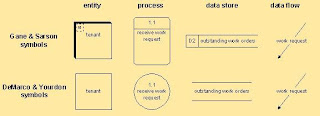Uses and Extend Arrows in Use Case Diagram
Uses Arrow:
The
uses arrow (or uses edge as it would be called in traditional graph theory) is
drawn from a use case X to another use case Y to indicate that the process of
doing X always involves doing Y at least once (although it may involve doing it
many times, "at least once" is the only relationship guaranteed by
this symbol.) This symbol can be referred to as an aggregation operator,
because it indicates that a given use case is an aggregate (made up of parts)
whose components are the use cases that it uses. If a certain use case uses
several others, that means that all of the component use cases must be
completed in the process of completing the aggregate use case, although there
is no specification in Use Case Diagrams of the order in which these are completed. A brief,
mnemonic way to think about the uses arrow is that it can be read X uses Y means
that "X has a Y" as part of it's behaviour.
Extends Arrow:
The extends arrow (or extends edge) is drawn
from a use case X to a use case Y to indicate that the process X is a special
case behaviour of the same type as the more general process Y. You would use
this in situations where your system has a number of use cases (processes) that
all have some subtasks in common, but each one has something different about it
that makes it impossible for you to just lump them all together into the same
use case.


Comments
Post a Comment